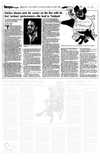Mickey Mouse puts his career on the line with his first 'serious' performance—the lead in 'Fantasia'
The internationally acclaimed Mickey Mouse was suffering from overexposure. To cure his alter ego, Disney launches a cartoon set to music, "Fantasia."
Third of Five Parts
"FANTASIA" came into being because of Walt Disney's concern for the career of Mickey Mouse.
Walt retained his almost mystical attachment to Mickey; to him the mouse was neither a revenue-producing cartoon character nor a goodluck talisman. Walt was Mickey's voice, his alter ego, and it troubled him to see the decline. But it had been inevitable. The beloved rodent had been an international attraction for a decade, and few movie stars could sustain careers for that long a time.
In the beginning, Mickey Mouse could do anything. He was drawn with a series of circles of varying sizes, and he moved with what animators call the "rubber-hose technique" – action with little relation to human or animal movement. As cartoons became more sophisticated, so did Mickey. Freddy Moore was the first to apply the "squash-and-stretch technique" to Mickey's animation, making him more human and appealing. Moore gave the face more character and definition; for the first time, Mickey had a cheek when his teeth went together.
Even with a more pliable face and figure, Mickey presented problems. He was cuter, but he lacked the primitive vitality of the early cartoons. With his shy manner, he was essentially a latent character, not the instigator of comic happenings. That function befell the broader supporting characters who, inevitably, became stars of their own series – Donald Duck and Pluto in 1937, Goofy in 1939. The sizes of all three made them easy to work with; Donald was the height of a duck, and Pluto and Goofy could be portrayed dog-size. But the Mickey story men and animators were faced with the recurrent problem: "What can you do with a 4-foot mouse?"
IN 1938, Disney decided to star Mickey Mouse in a cartoon presentation of "The Sorcerer's Apprentice," an old fairy tale that had been interpreted as a poem by Goethe and a concert piece by the French composer Paul Dukas. Mickey was cast as the apprentice whose misuse of the sorcerer's powers wreaks disaster. The entire action would be done in pantomime to the Dukas music. Walt seemed pleased that no dialog would be required; he suspected that Mickey's (Walt's) hesitant falsetto contributed to the character's difficulty in playing varied roles.
Disney planned to release "The Sorcerer's Apprentice" as a two-reeler, but that changed after a chance meeting with Leopold Stokowski, the distinguished conductor of the Philadelphia Orchestra. Walt mentioned that he was starring Mickey Mouse in "The Sorcerer's Apprentice." Stokowski, a devoted follower of Disney cartoons, volunteered to conduct the Dukas music.
[…]
